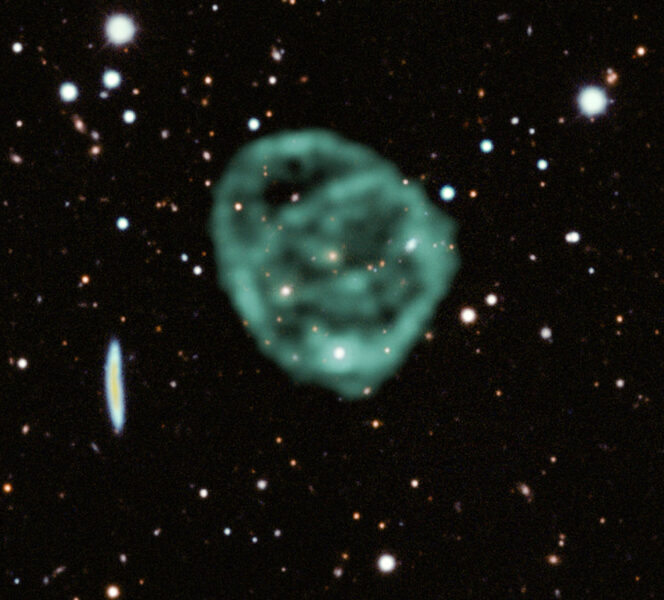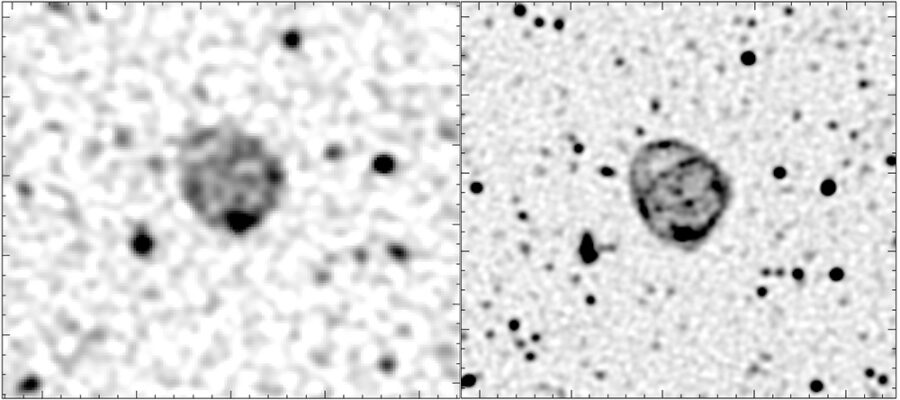Faint rings of radio emission, newly discovered around distant galaxies, might signal momentous events in galactic evolution. Then again, they might be something else entirely.

J. English (U. Manitoba) / EMU / MeerKAT / DES / DOE / FNAL / DECam / CTIO / NOIRLab / NSF / AURA
“Odd radio circles” are, well, odd. These ghostly rings of radio emission were only discovered last year and they appear to be quite rare: Astronomers have found three of them while surveying the radio-emitting sky, and later observations added only two more to that tally. Each one of these faint circles is a million light-years wide or more, encompassing multiple galaxies. None of them emit anything but radio waves — and we have no idea what made them.
Ray Norris (Western Sydney University, Australia) found the first of these circles last year, while using the Australian Square Kilometre Array Pathfinder (ASKAP) to conduct the pilot survey of the Evolutionary Map of the Universe (EMU), a survey of the Southern Hemisphere’s radio sky. ASKAP was well-suited to the task, as the 36-dish array mapped the sky with unprecedented speed, and Norris found three Odd Radio Circles (ORCs) in the data.
“We had hoped we might find new phenomena in EMU but perhaps not so quickly, and it looked like this might be it,” Norris says. “But as a scientist I have to try to hose down my excitement and go through the process of checking. . . . It was a long process, more than several months, from the initial rush of excitement to the stage where we were confident that this really was new phenomenon, not previously seen.”
Now Norris and his colleagues report in a study to appear in the Monthly Notices of the Royal Astronomical Society (preprint available online) that they have taken a closer look at the first ORC using the 64 interlinked dishes that make up the South African MeerKAT telescope. MeerKAT’s larger and broader array offered a sharper view and revealed details not seen before.

EMU / ASKAP / MeerKAT
Key to this study is the ORC's distance, about which the radio emission offers no clues. The team originally had to consider the possibility that these were actually much smaller objects in the Milky Way, but the distribution of the five known ORCs across the sky (and not along the galactic plane), argued for extragalactic sources.
“The authors have argued convincingly in their previous work that at least some ORCs are associated with galaxies," says astrophysicist George Heald (CSIRO, Australia), who was not involved in the study. "It’s through the association with the host galaxy that we can pin a distance to an ORC and determine that they are huge objects, typically 1 million to 2 million light-years across.”
In the current study, the team drew on archival images of the ORC environment from visible and infrared sky surveys, showing that a large elliptical galaxy sits dead center in the middle of the ring. At its core is a supermassive black hole that’s devouring gas and producing radio emission of its own. This galaxy, the astronomers argue, is most likely the source of the much larger ORC 1 ring.
ORCs’ Origin(s)
It’s possible that the black hole at the galaxy’s core is itself the product of a black hole collision, which might have sent shock waves out into the surrounding material. Norris says exploring this option more fully will be the focus of a future study.
Another possibility, which the current study explores in more detail, is that the central galaxy underwent a burst of star formation in its past. Particles and gas streaming away from stars both newborn and dying would have pushed out a galactic wind, which, like the black hole merger, could have set off a spherical shock wave. To provide enough power, some 20 billion Suns’ worth of stars would have needed to ignite over millions of years.
Both of these possibilities are consistent with the MeerKAT observations. The data suggest a third scenario, that we are staring down the barrel of a black hole’s jet, appears less likely, Norris says. But, he adds, “my colleagues and I continue to debate this.”
Whatever set off the wave or wind, it would have expanded inexorably, passing out of the galaxy and into intergalactic space, becoming a thin and remarkably symmetric spherical shell. We only see its edges for the same reason that it’s easier to see the edges of a soap bubble, because that’s where there’s more material along our line of sight.
The astronomers speculate that, as this shell passed surrounding galaxies, it interacted with them, producing the arcs within the ring that MeerKAT resolved.
As the shell keeps expanding, the charged particles it carries continue to emit radio waves as they wind their way around magnetic fields. By measuring the brightness of the shell, Norris and colleagues estimate that the originating event occurred some 100 million years ago.
“The authors’ work on ORCs is an intriguing detective story,” Heald says. “The authors have been creative and thorough in coming up with possible scenarios.”
Heald is particularly intrigued by the ordered magnetic field structure that the MeerKAT data reveal. “I suspect this type of image will play a key role in finally determining the origin of ORCs.” More detailed analysis of the polarization data could, for example, reveal a 3D picture of the magnetic field.
The Search for ORCs Continues
“A few years ago, there was no radio telescope on Earth which could have found them,” Norris says. ORCs escaped previous detection because they are both faint and rare, though how rare is still uncertain. ASKAP, which has just finished a set of pilot surveys (including EMU), may yet discover more of them.
“I thought [ORCs] would be hard to find, and we would need artificial intelligence techniques to find them,” Norris says. “But in the end, the good old human eyeball turned out to be the best way of finding these.”
Human eyeballs have also spotted other, not-quite-ORC things in the EMU data. “We have a number of ‘ORC candidates,’ which look a bit like ORCs but don't quite have the distinctive edge-brightened circle of radio emission,” Norris says. “So are they slightly wonky ORCs, or something else entirely, like a cluster halo? We need to do more work to find out.”
As ASKAP begins full operations this year, Heald is also looking forward to see what more they can find: “This paper shows us that with ASKAP’s efficient search capability, coupled with MeerKAT’s exquisitely detailed view of individual objects, we are better equipped than ever before to explore the radio universe.”
 1
1









Comments
Martian-Bachelor
April 5, 2022 at 6:21 pm
> a large elliptical galaxy sits dead center in the middle of the ring
> ...which might have sent shock waves out into the surrounding material.
The first quote makes these seem related somehow to classical double-lobed radio sources, but something different is obviously happening. Instead of shooting out jets in opposite directions the thing is just "oozing" radio emitting material (for lack of a better term).
The problem with the second quote is that elliptical galaxies are devoid of interstellar material, so there wouldn't ordinarily be any "surrounding material" for shock waves to occur in. Any material would have had to have originated in the central source itself.
Curious, and interesting... Have they been able to get any kind of spectrum? Such would tell us for sure if the radio emission is synchrotron radiation. Presumably if they're looking for polarization that would be something you'd look for if it was synchrotron radiation. But since this has no line features you can't measure any Doppler shifts, and thus one can't determine how quickly it's expanding.
You must be logged in to post a comment.
You must be logged in to post a comment.